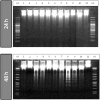Antiproliferative activity of long chain acylated esters of quercetin-3-O-glucoside in hepatocellular carcinoma HepG2 cells
- PMID: 25681471
- PMCID: PMC4935297
- DOI: 10.1177/1535370215570828
Antiproliferative activity of long chain acylated esters of quercetin-3-O-glucoside in hepatocellular carcinoma HepG2 cells
Abstract
Despite their strong role in human health, poor bioavailability of flavonoids limits their biological effects in vivo. Enzymatically catalyzed acylation of fatty acids to flavonoids is one of the approaches of increasing cellular permeability and hence, biological activities. In this study, six long chain fatty acid esters of quercetin-3-O-glucoside (Q3G) acylated enzymatically and were used for determining their antiproliferative action in hepatocellular carcinoma cells (HepG2) in comparison to precursor compounds and two chemotherapy drugs (Sorafenib and Cisplatin). Fatty acid esters of Q3G showed significant inhibition of HepG2 cell proliferation by 85 to 90% after 6 h and 24 h of treatment, respectively. The cell death due to these novel compounds was associated with cell-cycle arrest in S-phase and apoptosis observed by DNA fragmentation, fluorescent microscopy and elevated caspase-3 activity and strong DNA topoisomerase II inhibition. Interestingly, Q3G esters showed significantly low toxicity to normal liver cells than Sorafenib (P < 0.05), a chemotherapy drug for hepatocellular carcinoma. Among all, oleic acid ester of Q3G displayed the greatest antiproliferation action and a high potential as an anti-cancer therapeutic. Overall, the results of the study suggest strong antiproliferative action of these novel food-derived compounds in treatment of cancer.
Keywords: HepG2 cells; Quercetin-3-O-glucoside; acylation; apoptosis; cancer; caspase-3; cell cycle; chemotherapy; hepatocellular carcinoma; topoisomerase II.
© 2015 by the Society for Experimental Biology and Medicine.
Figures









Similar articles
-
Quercetin-3-O-glucoside induces human DNA topoisomerase II inhibition, cell cycle arrest and apoptosis in hepatocellular carcinoma cells.Anticancer Res. 2014 Apr;34(4):1691-9. Anticancer Res. 2014. PMID: 24692698
-
Flavonoid-enriched apple fraction AF4 induces cell cycle arrest, DNA topoisomerase II inhibition, and apoptosis in human liver cancer HepG2 cells.Nutr Cancer. 2014;66(7):1237-46. doi: 10.1080/01635581.2014.951733. Epub 2014 Sep 25. Nutr Cancer. 2014. PMID: 25256427
-
Fatty acid esters of phloridzin induce apoptosis of human liver cancer cells through altered gene expression.PLoS One. 2014 Sep 17;9(9):e107149. doi: 10.1371/journal.pone.0107149. eCollection 2014. PLoS One. 2014. PMID: 25229655 Free PMC article.
-
[Enzymatic synthesis of acylated quercetin 3-O-glycosides: a review].Sheng Wu Gong Cheng Xue Bao. 2021 Jun 25;37(6):1900-1918. doi: 10.13345/j.cjb.200769. Sheng Wu Gong Cheng Xue Bao. 2021. PMID: 34227284 Review. Chinese.
-
Application of Quercetin in the Treatment of Gastrointestinal Cancers.Front Pharmacol. 2022 Apr 6;13:860209. doi: 10.3389/fphar.2022.860209. eCollection 2022. Front Pharmacol. 2022. PMID: 35462903 Free PMC article. Review.
Cited by
-
Quercetin shows anti-tumor effect in hepatocellular carcinoma LM3 cells by abrogating JAK2/STAT3 signaling pathway.Cancer Med. 2019 Aug;8(10):4806-4820. doi: 10.1002/cam4.2388. Epub 2019 Jul 5. Cancer Med. 2019. PMID: 31273958 Free PMC article.
-
Kinetic study on the inhibition of xanthine oxidase by acylated derivatives of flavonoids synthesised enzymatically.J Enzyme Inhib Med Chem. 2017 Dec;32(1):978-985. doi: 10.1080/14756366.2017.1347165. J Enzyme Inhib Med Chem. 2017. PMID: 28718686 Free PMC article.
-
Synergistic antitumor effect of resveratrol and sorafenib on hepatocellular carcinoma through PKA/AMPK/eEF2K pathway.Food Nutr Res. 2021 Oct 13;65. doi: 10.29219/fnr.v65.3602. eCollection 2021. Food Nutr Res. 2021. PMID: 34776832 Free PMC article.
-
Long Chain Fatty Acid Esters of Quercetin-3-O-glucoside Attenuate H₂O₂-induced Acute Cytotoxicity in Human Lung Fibroblasts and Primary Hepatocytes.Molecules. 2016 Apr 6;21(4):452. doi: 10.3390/molecules21040452. Molecules. 2016. PMID: 27058521 Free PMC article.
-
Antitumor Effects of Quercetin in Hepatocarcinoma In Vitro and In Vivo Models: A Systematic Review.Nutrients. 2019 Nov 25;11(12):2875. doi: 10.3390/nu11122875. Nutrients. 2019. PMID: 31775362 Free PMC article.
References
-
- Rupasinghe HPV, Nair S, Robinson R. Chemopreventive properties of fruit phenolics and their possible mode of actions. In: Atta-Ur-Rahman (ed.). Studies in natural products chemistry 2014; Vol 42Amsterdam: Elsevier Science Publishers, pp. 229–66.
-
- Arts IC, Hollman PC, De Mesquita HB, Feskens EJ, Kromhout D. Dietary catechins and epithelial cancer incidence: the Zutphen elderly study. Int J Cancer 2001; 92: 298–302. - PubMed
-
- Knekt P, Kumpulainen J, Järvinen R, Rissanen H, Heliövaara M, Reunanen A, Hakulinen T, Aromaa A. Flavonoid intake and risk of chronic diseases. Am J Clin Nutr 2002; 76: 560–8. - PubMed
-
- Le Marchand L, Murphy SP, Hankin JH, Wilkens LR, Kolonel LN. Intake of flavonoids and lung cancer. J Natl Cancer Inst 2000; 92: 154–60. - PubMed
-
- Shen SC, Chen YC, Hsu FL, Lee WR. Differential apoptosis-inducing effect of quercetin and its glycosides in human promyeloleukemic HL-60 cells by alternative activation of the caspase 3 cascade. J Cell Biochem 2003; 89: 1044–55. - PubMed
Publication types
MeSH terms
Substances
LinkOut - more resources
Full Text Sources
Other Literature Sources
Research Materials

